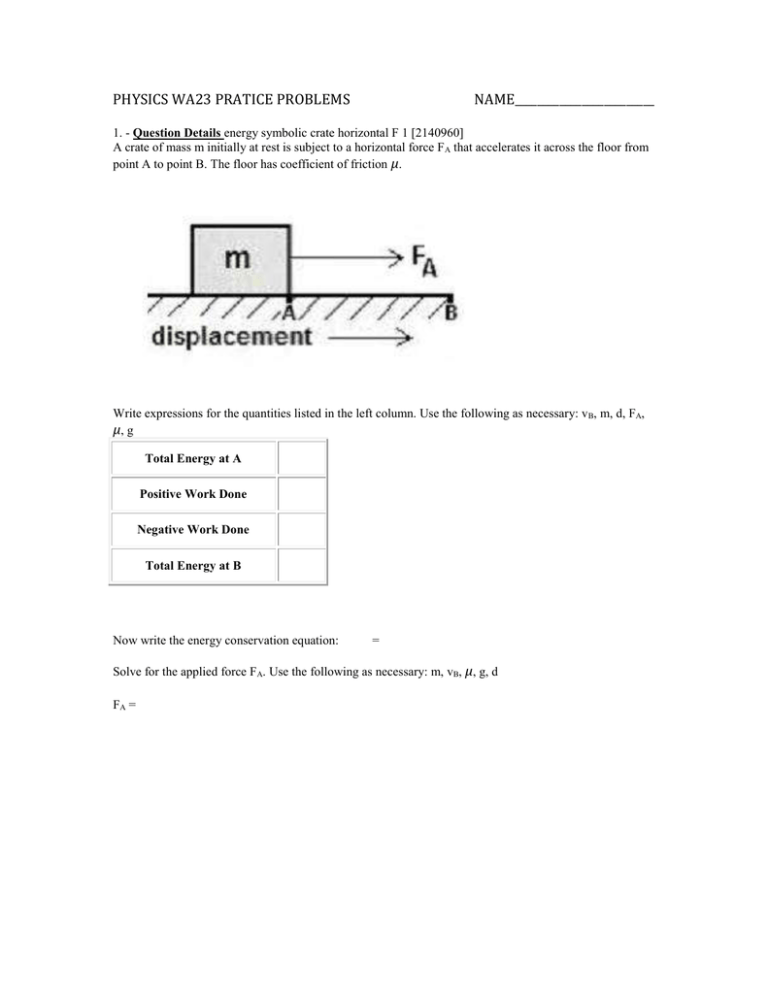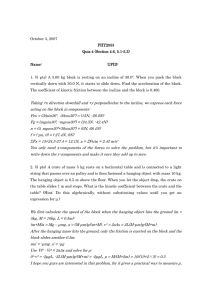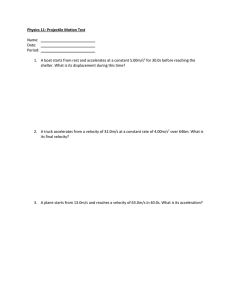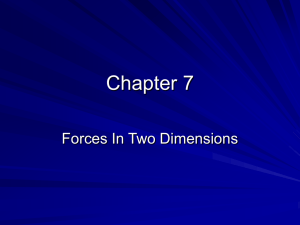PHYSICS WA23 PRATICE PROBLEMS NAME_________________________
advertisement

PHYSICS WA23 PRATICE PROBLEMS NAME_________________________ 1. - Question Details energy symbolic crate horizontal F 1 [2140960] A crate of mass m initially at rest is subject to a horizontal force F A that accelerates it across the floor from point A to point B. The floor has coefficient of friction μ. Write expressions for the quantities listed in the left column. Use the following as necessary: v B, m, d, FA, μ, g Total Energy at A Positive Work Done Negative Work Done Total Energy at B Now write the energy conservation equation: = Solve for the applied force FA. Use the following as necessary: m, vB, μ, g, d FA = 2. - Question Details Energy crate horizontal 1 [1691412] A crate of mass 23.3 kg is initially at rest on a horizontal surface with a coefficient of friction μ = 0.167. A horizontal applied force of 129 N accelerates the crate through a displacement of 26.8 m. A. What is the total energy in the system at point A? B. What is the work done by the applied force? C. What is the work done by friction? 0.00 J 3460 J 1020 J D. What is the total energy in the system at point B? E. What is the velocity of the crate at point B? 2440 J 14.5 m/s F. What is the time interval between points A and B? G. What is the power exerted by the applied force? 3.71 s 933 W 3. - Question Details energy symbolic crate depression F 2 [2141211] A crate initially at rest is subject to a force FA at a depression angle θ that accelerates it across the floor from point A to point B. The floor has coefficient of friction μ. Write expressions for the quantities listed in the left column. Use the following as necessary: v B, m, d, FA, μ, θ, g Total Energy at A Positive Work Done Negative Work Done Total Energy at B Now write the energy conservation equation: = Solve for the mass of the crate. Use the following as necessary: F A, vB, μ, θ, g, d m= 4. - Question Details Energy crate depression angle 1 [1691721] A crate of mass 33.4 kg is initially at rest on a horizontal surface with a coefficient of friction μ = 0.229. An applied force of 519 N with a depression angle of 25.2° accelerates the crate through a displacement of 48.0 m. A. What is the total energy in the system at point A? B. What is the work done by the applied force? C. What is the work done by friction? 0.00 J 22500 J -6030 J D. What is the total energy in the system at point B? 16500 J E. What is the velocity of the crate at point B? 31.4 m/s F. What is the time interval between points A and B? 3.05 s G. What is the power exerted by the applied force? 7390 W 5. - Question Details energy symbolic proj horizontal 2 [2133549] A projectile of mass m is launched horizontally from the edge of a cliff of height H with an initial velocity vA. Point A is when the projectile leaves the launcher, and point B is just as it hits the ground. Write expressions for the quantities listed in the left column. Use the following as necessary: v A, vB, m, H, g Total Energy at A Positive Work Done Negative Work Done Total Energy at B Now write the energy conservation equation: = Solve for the initial velocity of the projectile. Use the following as necessary: v B, H, g vA = 6. - Question Details energy symbolic proj cliff elevation 1 [2443635] A projectile of mass m is launched from the edge of a cliff of height H with an initial velocity v 0 at elevation angle θ. Point A is when the projectile leaves the launcher, point B is when it is at its highest point, and point C is just as it hits the ground. Write expressions for the quantities listed in the left column. Note that this problem refers to points A and B. Use the following as necessary: v0, vB, m, H, HB, g Total Energy at A Positive Work Done Negative Work Done Total Energy at B Now write the energy conservation equation: = Solve for the height of the projectile at point B. Use the following as necessary: v 0, vB, g, H HB = 7. - Question Details energy symbolic proj cliff elevation 4 [2443678] A projectile of mass m is launched from the edge of a cliff of height H with an initial velocity v 0 at elevation angle θ. Point A is when the projectile leaves the launcher, point B is when it is at its highest point, and point C is just as it hits the ground. Write expressions for the quantities listed in the left column. Note that this problem refers to points B and C. Use the following as necessary: vB, vC, m, HB, g Total Energy at B Positive Work Done Negative Work Done Total Energy at C Now write the energy conservation equation: = Solve for the velocity of the projectile at point C. Use the following as necessary: v B, g, HB vC = 8. - Question Details Energy projectile 1 [1691739] A projectile of mass 2.65 kg is fired with an initial velocity of 30.9 m/s and an elevation angle θ = 47.9° from the edge of a cliff of height 197 m. Measure gravitational potential energy from the ground at the base of the cliff. Note that point A is as the projectile leaves the launcher, point B is the highest point it reaches, and point C is as the projectile reaches the ground. A. What is the gravitational potential energy at point A? B. What is the kinetic energy at point A? 5120 J 1270 J C. What is the total mechanical energy in the system? D. What is the velocity of the projectile at point B? E. What is the kinetic energy at point B? 6380 J 20.7 m/s 569 J F. What is the gravitational potential energy at point B? G. What is the height of the projectile at point B? 224 m H. What is the gravitational potential energy at point C? I. What is the kinetic energy at point C? 5810 J 0.00 J 6380 J J. What is the velocity of the projectile at point C? 69.4 m/s 9. - Question Details energy symbolic box on ramp4 [2181019] A box of mass m starts from rest at point A, some distance d up the inclined plane as shown. The plane is inclined at an angle θ and has coefficient of friction μ. The box accelerates down the plane. Note the positions of points A, B, and C; point B is halfway down the plane, and point C is at the bottom. Write expressions for the quantities listed in the left column. Note that this problem refers to points B and C. Use the following as necessary: m, g, d, θ, μ, vB, vC Total Energy at B Positive Work Done Negative Work Done Total Energy at C Now write the energy conservation equation: = Solve for the distance d. Use the following as necessary: g, μ, θ, vB, vC d= 10. - Question Details Energy crate on ramp 1 [1691747] A crate of mass 11.0 kg is initially at rest at the top of a ramp of length 6.03 m and elevation angle θ = 32.0° and a coefficient of friction μ = 0.115. The crate slides down the ramp to the bottom. Note the locations of points A, B, and C on the diagram. Point B is halfway down (or halfway up, depending on your degree of optimism). A. What is the gravitational potential energy at point A? B. What is the kinetic energy at point A? 344 J 0.00 J C. What is the work done by friction between points A and B? D. What is the gravitational potential energy at point B? E. What is the kinetic energy at point B? -31.7 J 172 J 141 J E. What is the velocity of the crate at point B? 5.05 m/s F. What is the work done by friction between points A and C? G. What is the gravitational potential energy at point C? H. What is the kinetic energy at point C? 0.00 J 281 J I. What is the velocity of the crate at point C? 11. - Question Details Giancoli5 6.P.005. [9892] 7.15 m/s -63.4 J How high will a 0.370 kg rock go if thrown straight up by someone who does 118 J of work on it? Neglect air resistance. 32.5m 12. - Question Details Giancoli5 6.P.013. [9900] The x component of the force on an object varies as shown in Fig. 6-36. Figure 6-36. (a) Determine the work done by this force to move the object from x = 0.0 to x = 5.0 m. (b) Determine the work done by this force to move the object from x = 0.0 to x = 10.0 m. 1400J 2800J 13. - Question Details Giancoli5 6.P.040. [9926] A roller coaster, shown in Fig. 6-38 (h1 = 35 m, h2 = 14 m, h3 = 29 m), is pulled up to point A where it and its screaming occupants are released from rest. Assuming no friction, calculate the speed at points B, C and D. point B 26.2 m/s point C 10.8 m/s point D 20.3 m/s Figure 6-38.







